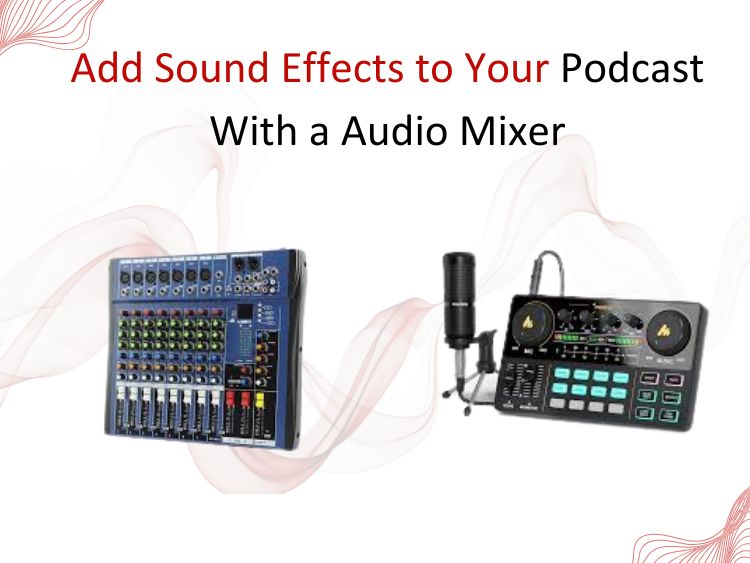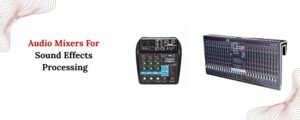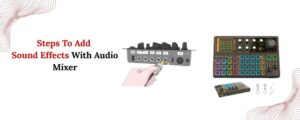In today’s cut-throat world of podcasting, capturing your listeners’ attention and maintaining it is crucial – and sound effects can greatly enhance this. From a subtle background ambience to dramatic stings before plot twists to quirky transitions between segments, sound effects infuse creativity and professionalism into your audio content.
But how do you apply them in real-time? Meet the audio mixer; it’s a tool that allows you to control, cue, and blend sound effects into your episodes seamlessly. In this article, we will show you how to integrate sound effects into your podcast using a mixer so that you can give your content the competitive edge it needs.
For a detailed list of audio mixers, check the best collection of 5 Core audio mixers!
Why Bring a Mixer Into Sound Effects Processing?
Podcasts or any audio production can be done by a single person, but the use of a mixer elevates your project to new levels. With a mixer, you can:
- Live trigger sound effects
- Control the volumes of a voice and its corresponding effect
- Add transitions and give the effect of layers
- Complete the entire task before seeking feedback
Mixers allow a single individual to produce multiple audio files in a short time while maintaining stamina throughout the recording. Furthermore, this assures a better user experience for consumers of sound content.
What You Will Need?
The following items are essential before you start –
- An Audio Mixer – 5 Core MX-6BT, Yamaha MG10XU, Behringer Xenyx Q802USB
- Laptop or Smartphone as Operator of Sound Effects
- 3.5mm to Dual 1/4 TS Cable / RCA to 3.5mm cable (For Mixers)
- Predefined Sound Effects
- Headphones or Mobile Monitors for Sound Monitoring
Step-by-Step: How to Add Sound Effects with a Mixer
Step 1: Connect Your Sound Source
Most podcasters are the users of a smartphone, a tablet, or a laptop as the sound effect player. To connect this to your mixer:
- Add the same 3.5mm cable to the device’s headphone jack or audio out where your device was connected.
- Insert the other end (1/4” or RCA) into the stereo input channel on the mixer.
- Name the channel mentally or with tape (e.g., “FX”) so you know which one controls your effects.
Step 2: Load Your Sound Effects
Do some preparations of those sound effects that you will use to make your sound library effective before the recording. You may need to –
- Search and download royalty-free MP3/WAV clips.
- Use apps similar to Soundboard Studio (iOS) or Custom Soundboard (Android) which are user-friendly on mobile phones.
- Make a set of background loops, transition sounds, applause, or buzzer sounds.
Remember to place the list in the order of the scenes or segments for quick and easy access when you start recording.
Want to know about mixing different tracks at one go? Read – Recording Multiple Tracks with a Mixer!
Step 3: Control Levels on the Mixer
After the initial connection –
- Adjust the level with the gain knob and channel faders.
- Your sound effects should not overshadow your voice.
- If your mixer has pan controls, keep effects in the center unless you want a stereo spread.
- It helps to monitor with headphones to adjust your mix’s effects.
With the above steps, you control the familiar problems of: “effects way too loud” or “almost inaudible” where all the effects are meant to aid.
Step 4: Real-Time Recording or Use a DAW
Your setup is complete. Now you can –
- Start recording with your main DAW (Audacity, GarageBand, Adobe Audition, etc.).
- Play sound effects during a live recording of your podcast.
- Control volume, balance, or fade-ins/outs using the mixer while you are playing.
This technique enhances listener engagement and creates the impression of a “live” recording while reducing overall post-production work.
Best Mixers for Adding Sound Effects
Below are some suggested mixers that can be trusted:
- 5 Core MX-6BT – A cost-effective option featuring Bluetooth connection and multiple channel inputs for sound effect integration.
- Yamaha MG10XU – Versatile for podcasting with high-quality preamps, onboard effects, and versatile podcasting capabilities.
- Behringer Xenyx Q802USB – Compact and ready for USB connection, ideal for solo podcasters or smaller setups.
Final Thoughts
Using a mixer to incorporate sound effects into your podcast can instantly make you more creative and bring back the traditional way of storytelling. This is a potent tool in your hands that will allow you not only to effectively communicate with your listeners on a deeply personal level, but also, more significantly, create a professional, full of life and dynamic content.
If you want to buy a high-quality audio mixer, then 5 Core MX 20CH XU is one of the best options.
It doesn’t matter if you have a modest 5 Core mixer or a more expensive Yamaha, what is important is that you have made a plan about your FX and flow, your skills are ready and you are confident with what your ears tell you. In a matter of minutes, with the right set of the device and some practice, you will hit upon new possibilities for the sound of your podcast.



